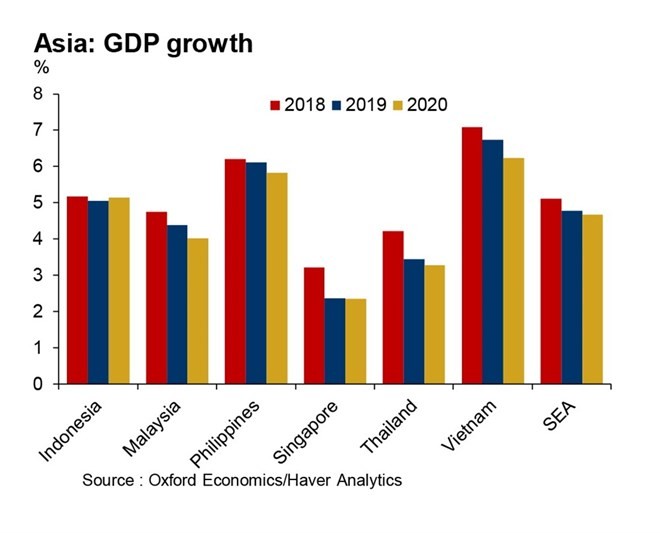
In a report, “Economic Insight: South-East Asia”, it said growth would further ease to 4.7 percent in 2020.
Export growth would decelerate amid increased trade protectionism and slower Chinese demand.
Vietnamese growth was forecast to slow down to 6.7 percent this year and 6.2 percent in 2020.
Economies started the year on a soft note as a result of the weakness in global economic activity in late 2018, and regional merchandise exports growth tumbled last December following a weak November.
The deterioration in export momentum was broad-based, with only Malaysia recording positive annual growth. While Singapore and China data showed some improvement in exports in January, the data was likely to be volatile in the first quarter given the timing of Chinese New Year.
Sian Fenner, ICAEW economic advisor and Oxford Economics lead Asia economist, said: “Looking ahead, we expect the risks to the economic outlook of the region to be primarily to the downside. A sharper slowdown in Chinese economic growth, triggered by worsening confidence or a renewed escalation in US-China trade tensions, will both affect global trade and growth across the region.
“That said, we do not expect the external environment to be as worrisome as it was in 2015-16, as China’s growth is also expected to stabilise in the second quarter.”
The report expected domestic demand to provide some relief together with accommodative macro policies.
“Most central banks are likely to keep policy rates unchanged well into the second half of 2019 amid muted inflationary pressures. Expansionary fiscal policy will also help, with fiscal spending expected to be strong in Indonesia, Thailand and the Philippines ahead of upcoming elections in first half of 2019.”
There were pockets of concern, however, with regard to investment growth in certain countries. In Singapore and Malaysia, private capital expenditure, especially in machinery and equipment investment, had been on a downward trend.
Residential investment would also be held back by demand and supply imbalances in both those economies.
On a more positive note, construction, particularly infrastructure investment, was expected to limit the downside to overall investment.
Benign inflationary conditions and rising real income growth would also continue to support household spending.
Mark Billington, ICAEW regional director, Southeast Asia, said: “Although we expect domestic demand to remain resilient, the impact of increased trade tensions in the past year and slower Chinese import demand is likely to act as a drag on the region’s growth as a whole.
“The outlook for Asia trade may continue to face a challenging export environment.”
























